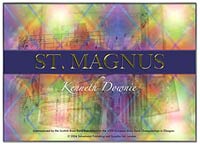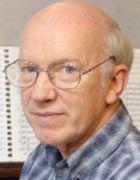2008 Scottish Open Brass Band Championship - Test piece review
26-Nov-20084BR first encountered Kenneth Downies great test piece back in 2004.
 This music is a set of variations on the tune known as St Magnus, which is attributed to Jeremiah Clarke. Most people will associate it with Thomas Kelly's hymn which begins:
This music is a set of variations on the tune known as St Magnus, which is attributed to Jeremiah Clarke. Most people will associate it with Thomas Kelly's hymn which begins:
"The Head that once was crowned with thorns Is crowned with glory now".
The tune is very simple, consisting of just two, four-bar phrases. Neither is there much in the way of rhythmic variety, every note being a crotchet with the exception of two quavers, and the last note in each phrase. Within such a simple structure, however, lies considerable strength.
Theme:
The listener is given the opportunity of hearing it twice, in full, at the beginning, starting with one player but soon taken up by the full ensemble. It returns in the middle of the music and is stated again near the end. This has been done quite deliberately in the hope that there will be an appreciation of what material is being developed, by the listener as well as by those with access to the score, who are able to see the visual connections.
Variation 1:
This takes the rhythm of the last part of the theme and also uses the shape of the opening as a recurring figure. The mood is whimsical and skittish, with short, teasing rhythmic figures tossed around the band, and quick interplay with percussion, at a fast tempo. An energetic flourish finishes this variation before the Andante espress.
Variation 2:
This commences with chords related to the opening of Variation 1. The cantabile on solo cornets establishes a new, lyrical mood and there is scope for expressive playing in a series of short solo passages. The theme works its way unobtrusively into the texture before a reprise of the solo cornet melody and some more lyrical interchanges between Eb tuba, euphonium, flugel horn and cornets. The variation ends serenely with clear references to the last phrase of the theme.
Variation 3: Allegro con moto
The first idea to dominate is clearly linked to the shape of the theme's first phrase. There is a frenetic feel to much of this variation, with considerable energy and instability created by extensive use of cross-rhythms. A thinning-out of the score marks a clear change to development of the start of the second phrase of the theme. This proves to be short-lived however, and the opening material returns leading to a restatement of the theme, "Maestoso" after which a euphonium cadenza links to:
Variation 4:
Here we have some solos for euphonium, cornet, trombone and tuba set against a background of horns and baritones presenting a pensive statement of the theme's opening.
Variation 5:
This commences Allegro, with lively work for cornet and euphonium spreading to the whole band before attention focuses on the beginning of the second phrase of the theme which is initially presented in diminution, then in regular rhythm, then in inversion. An increase in tempo coupled with a decrease in volume, requires dexterity and control, with several metrical challenges thrown in for good measure. The same fragment of phrase becomes an ostinato which generates a frenzied climax, punctuated by short, dramatic silence, before the opening figure returns and the music gradually winds down.
The tubular bells herald the final return of the theme, in augmentation, marking the start of the:
Finale:
With the running semiquavers of the previous variation sounding in counterpoint. A fast, furious coda speeds the work to a conclusion while references to the opening of the theme are still trying to break into the texture of the music.
Kenneth Downie
 Profile: Kenneth Downie
Profile: Kenneth Downie
Kenneth Downie was born in Glasgow in 1946 and educated at Greenock High School, the Royal Manchester College of Music and Durham University. He then became a specialist music teacher in schools before finally leaving his position as head of music at Poole Grammar School to go into the jewellery business in 1976.
Compositions
His published compositions, now numbering over 70, many of which has been recorded and broadcast on national radio, span a period of 30 years and are mainly for brass band or choir. In 1997 and 1999 his ‘Purcell Variations’ and ‘Music for the Common Man’ were chosen as section one regional test pieces for the National Brass Band Championships. In 2001 his 'St. Austell Suite' was the section three test piece.
In April 1998 he was appointed Composer in Residence to the Yorkshire Building Society Band and thus began a fruitful relationship involving concerts, broadcasts and recordings.
In July 2001 he was appointed creative music consultant to the Salvation Army, working for three days each week in the Music Ministries Unit of the Evangelism Department.
With his wife Patricia he established the music publishing company 'Kantaramusik' in 2001. Kenneth lives in Winchester with his wife Patricia, also a musician who teaches pianoforte and singing, and they are both active in the Salvation Army Church, Kenneth being Bandmaster and Patricia Songster Leader.
Kenneth's involvement in the Salvation Army Music Scene has afforded him the opportunity to travel throughout the world as, along with his wife, he has been involved in music schools and clinics in the USA, Canada, France, Sweden, and Holland.
The Scottish Brass Band Association were delighted when Kenneth accepted the commission of the 2004 European Championship test piece.
Music
The music is a set of variations on the tune known as St Magnus, which is attributed to Jeremiah Clarke. Most people will associate it with Thomas Kelly's hymn which begins:
"The Head that once was crowned with thorns
Is crowned with glory now".
Strength
The tune is very simple, consisting of just two, four-bar phrases. Neither is there much in the way of rhythmic variety, every note being a crotchet with the exception of two quavers, and the last note in each phrase. Within such a simple structure, however, lies considerable strength.
The listener is given the opportunity of hearing it twice, in full, at the beginning, starting with one player but soon taken up by the full ensemble. It returns in the middle of the music and is stated again near the end.
This has been done quite deliberately in the hope that there will be an appreciation of what material is being developed, by the listener as well as by those with access to the score, who are able to see the visual connections.















